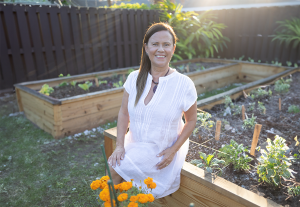No Products in the Cart

Vitamin D is one of those nutrients we tend to forget about.
Maybe you remember from your childhood that it’s in milk. But other than that, no one’s talking about how important this crucial vitamin is for your entire body including your pelvic floor.
But vitamin D is truly important for:
• Breast health
• Pelvic floor
• Immune health
• Hormone balance
• Bones
• Brain health
And so much more!

But here’s the thing. Most women are not getting enough vitamin D. In fact, according to government estimates, 97% of women get less than the estimated average requirement (EAR) of vitamin D from food and beverages…even though so many of our processed foods are fortified with it. (1)
Let’s take a look at why that is and what you can do about it.
Why Your Body Needs Vitamin D

First off, let’s discuss why vitamin D is so important for your body.
You have vitamin D receptors all over your body — in the small intestine, large intestine, T and B lymphocytes, brain, mononuclear cells, and skin. Vitamin D is crucial for insulin production, immune function, and bowel function.
It even affects your hormones, brain, and heart muscle. (2)
Vitamin D is also important for:
Breast Wellness

Did you know that women with lower levels of vitamin D may be at higher risk for breast cancer?
According to research, it could be as much as 45% more risk. And breast cancer patients are more likely to have lower vitamin D levels when tested. (3,4,5)
One study looked at women who worked outdoors and compared their breast cancer risk to women who worked inside.
The women who had 20 years or more of exposure to sunlight regularly had the lowest risk of breast cancer. (6) Scientists believe this is because vitamin D plays a role in breast cell growth.

There’s also a relationship between vitamin D and your vaginal tissues. Studies indicate that when vitamin D is administered via suppository, it can help reverse vaginal atrophy in post-menopausal women. (7,8)
It also appears there could be a relationship between women with pelvic organ prolapse and vitamin D deficiency. In one study, researchers found vitamin D levels were significantly lower in women with prolapse. (9)
One study even showed vitamin D applied topically was effective in treating bacterial vaginosis. (9)
Why You Probably Aren’t Getting Enough Vitamin D

Here’s the thing. Other than processed foods fortified with vitamin D, there aren’t a whole lot of foods that are packed with vitamin D.
Sure, there’s cod liver oil, sardines, and beef liver, but most of us don’t regularly pile our plates sky-high with any of these foods.
So that brings us to the other way we get vitamin D — the sun.
When the sun hits your skin, an organic compound called 7-dehydrocholesterol absorbs UV B radiation and then it is converted to previtamin D3 which in turn isomerizes into vitamin D3 (2)
This process is your body’s primary source of vitamin D, but it can also spell serious danger for you.
Why?
Because even short amounts of sun time can put you at risk for exposure to UV radiation, which damages your skin.
UV radiation is considered a carcinogen, meaning it causes skin cancer. (3,4)
And, here’s the other problem with vitamin D synthesis from sun exposure…most of us don’t get outside enough to even trigger the process because we’re inside so much.
Then, there’s the matter of cloudy days during the winter that just don’t bring enough of the UV-B rays you need to make vitamin D.
The Problem With Most Vitamin D Supplements

I don’t know about you, but I’d much rather slather on sunscreen, wear long sleeves, and protect my skin from the dangers of UV radiation — and just get my vitamin D from a supplement.
I’m not willing to sacrifice my skin for vitamin D.
I like my face wrinkle-free and my arms clear of age spots, thank you very much.
But there’s a huge problem with most vitamin D supplements out there.
You see, there are two basic types of vitamin D: D3 (cholecalciferol) and D2 (ergocalciferol).
D3 is the type that is made in your body and found in certain foods.
It is considered a much more “active” form of vitamin D, meaning your body can use it better and it actually contributes to raising the levels of vitamin D found in your body.
But a lot of the manufacturers out there cut corners and fill their supplements with the far less superior D2, because it’s less expensive to manufacture.
D2 simply isn’t as effective at raising your vitamin D levels as D3. And isn’t that the point of taking a vitamin D supplement?

Did you know that consuming vitamin D without vitamin K can put you at risk for increasing calcium in your blood?
Yep, vitamins D and K are both fat-soluble vitamins that play a central role in how your body metabolizes calcium.
Vitamin D promotes the production of vitamin K-dependent proteins, which require vitamin K for carboxylation. (5)
That means that when you supplement with vitamin D without the addition of vitamin K…calcium can build up in your blood and potentially increase your blood pressure. Yikes! (6)

So what’s a woman to do if she wants to make sure she’s getting enough vitamin D for her breasts and her bones…but NOT compromise her skin or increase her risk for heart disease
Supplement with a high-quality vitamin D3/K1/K2 supplement, of course.
But where do you find one of those?
Let me tell you a quick story about that.
You see, a few years ago, I was deep in the throes of a severe vitamin D deficiency.
I was feeling out of sorts, tired all the time, emotional, anxious…it was not fun.
My doctor ran a bunch of tests and finally came to the conclusion that I was deficient in vitamin D.
Now, with what I knew about vitamin D supplements, I went on a hunt for the best vitamin D3 supplement I could find that also had K1 and K2 in it.
And I couldn’t find one.
Eventually, I made my own!
And here we are >> Introducing the all-new Rootganic Total Fem Vitamin D Protect formula.
A blend of bioavailable and active D3, plus K1 and K2.
It’s the highest-quality, most potent combination of vitamin D + K on the planet.
And I’m so proud to bring it to you.
You can learn more about this incredible formula here.
References:

Isa Herrera, MSPT, CSCS is a New York City-based holistic women's pelvic floor specialist, author of 5 books on pelvic health, including the international best seller Female Pelvic Alchemy, and the ground-breaking self-help book, Ending Female Pain, A Woman's Manual. She has dedicated her career to advancing awareness of pelvic floor conditions so that more people can find relief from this silent epidemic that affects over 30 million people in the US alone. Ms. Herrera holds a BA in Psychology and Biology from Fordham University and also a Masters in Physical Therapy from Hunter College.